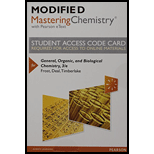
Concept explainers
a.
To determine:
The effect on the rate of a
Introduction:
The rate of a chemical reaction is the amount of reactant consumed in the given reaction in a given period of time or it can be defined as the amount of product formed in a given reaction in a given period of time.
b.
To determine:
The effect on the rate of a chemical reaction brought about by decreasing the amount of one of the reactant.
Introduction:
The rate of a chemical reaction is the amount of reactant consumed in the given reaction in a given period of time or it can be defined as the amount of product formed in a given reaction in a given period of time.
c.
To determine:
The effect on the rate of a chemical reaction brought about by caramelizing onions on a medium-high stove setting versus a low setting.
Introduction:
The rate of a chemical reaction is the amount of reactant consumed in the given reaction in a given period of time or it can be defined as the amount of product formed in a given reaction in a given period of time.
Want to see the full answer?
Check out a sample textbook solution
Chapter 5 Solutions
Modified Mastering Chemistry with Pearson eText -- Standalone Access Card -- for General, Organic, and Biological Chemistry (3rd Edition)
- . A(n) _______ speeds up a reaction without being consumed.arrow_forwardIndicate to which of the following types of reactions each of the statements listed applies: combination, decomposition, displacement, exchange, and combustion. More than one answer is possible for a given statement. a. Two reactants are required. b. Only one reactant is present. c. Two products are present. d. Only one product is present.arrow_forwardSketch an energy diagram graph representing an exothermic reaction, and label the following. a. Average energy of reactants b. Average energy of products c. Activation energy d. Amount of energy liberated during the reactionarrow_forward
- . What does it mean to say that all chemical reactions are, to one extent or another, reversible?arrow_forwardSketch an energy diagram graph representing an endothermic reaction, and label the following. a. Average energy of reactants b. Average energy of products c. Activation energy d. Amount of energy absorbed during the reactionarrow_forwardClassify each of the reactions according to one of the four reaction types summarized in Table 18.1. (a) Fe2O3(s) + 2 Al(s) 2 Fe(s) + Al2O3(s) rH = 851.5 kj/mol-rxn rS = 375.2 J/K mol-rxn (b) N2(g) + 2 O2(g) 2 NO2(g) rH = 66.2 kJ/mol-rxn rS = 121.6 J/K mol-rxn TABLE 18.1 Predicting Whether a Reaction Will Be Spontaneous Under Standard Conditionsarrow_forward
- Draw an energy diagram graph for an endothermic reaction where no catalyst is present. Then draw an energy diagram graph for the same reaction when a catalyst is present. Indicate the similarities and differences between the two diagrams.arrow_forwardIndicate what type, or types, of reaction each of the following represents: (a) H2O(g)+C(s)CO(g)+H2(g) (b) 2KClO3(s)2KCl(s)+3O2(g) (c) Al(OH)3(aq)+3HCl(aq)AlCl3(aq)+3H2O(l) (d) Pb( NO3)2(aq)+H2SO4(aq)PbSO4(s)+2HNO3(aq)arrow_forwardThe characteristics of four reactions, each of which involves only two reactants, are given. For each of the following pairs of the preceding reactions, compare the reaction rates when the two reactants are first mixed by indicating which reaction is faster. a. 1 and 2 b. 1 and 3 c. 1 and 4 d. 2 and 3arrow_forward
 General, Organic, and Biological ChemistryChemistryISBN:9781285853918Author:H. Stephen StokerPublisher:Cengage LearningChemistry: Matter and ChangeChemistryISBN:9780078746376Author:Dinah Zike, Laurel Dingrando, Nicholas Hainen, Cheryl WistromPublisher:Glencoe/McGraw-Hill School Pub Co
General, Organic, and Biological ChemistryChemistryISBN:9781285853918Author:H. Stephen StokerPublisher:Cengage LearningChemistry: Matter and ChangeChemistryISBN:9780078746376Author:Dinah Zike, Laurel Dingrando, Nicholas Hainen, Cheryl WistromPublisher:Glencoe/McGraw-Hill School Pub Co Chemistry: The Molecular ScienceChemistryISBN:9781285199047Author:John W. Moore, Conrad L. StanitskiPublisher:Cengage Learning
Chemistry: The Molecular ScienceChemistryISBN:9781285199047Author:John W. Moore, Conrad L. StanitskiPublisher:Cengage Learning Chemistry for Today: General, Organic, and Bioche...ChemistryISBN:9781305960060Author:Spencer L. Seager, Michael R. Slabaugh, Maren S. HansenPublisher:Cengage Learning
Chemistry for Today: General, Organic, and Bioche...ChemistryISBN:9781305960060Author:Spencer L. Seager, Michael R. Slabaugh, Maren S. HansenPublisher:Cengage Learning Chemistry for Engineering StudentsChemistryISBN:9781337398909Author:Lawrence S. Brown, Tom HolmePublisher:Cengage Learning
Chemistry for Engineering StudentsChemistryISBN:9781337398909Author:Lawrence S. Brown, Tom HolmePublisher:Cengage Learning





